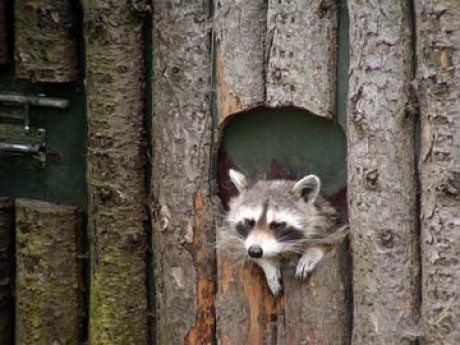When Good Critters Go Bad
By L.A. Jackson

It's nearly impossible to garden without experiencing at least some negative interactions with wildlife. The key to keeping your sanity while still nurturing wild things is to manage those human-animal interactions safely and humanely.
The first thing to remember is that most wildlife problems are relatively benign, says Jim Armstrong, a professor of wildlife sciences at Auburn University who specializes in human-wildlife interactions and wildlife damage issues. Armstrong notes that unless we encounter a sick or venomous creature, most wild animals that impact gardens are not dangerous; they are simply doing what comes naturally.
"They're just trying to make a living and we are helping them, whether we mean to or not," he said.
Gardens and landscapes attract wildlife because they offer easy sources of food and shelter. For that reason, Armstrong suggests putting a little space between the domestic and the wild worlds by developing a wildlife buffer strip around the home and garden. Position wildlife feeding areas and habitat structures (brush piles, bird and bat houses, etc.) as well as compost piles as far away from the house and garden as possible. And don't leave enticements, such as pet food or loose garbage, on or near the doorstop.
Also, lower the taste factor of your landscape. Numerous plants are available that are unattractive or downright unpalatable to wildlife, such as some pungent herbs, bitter-tasting shrubs and trees and even some herbaceous plants such as calendulas, irises, marigolds and fleabane.
The next choices are to repel, exclude or remove nuisance wildlife. Repellents can be chemical or mechanical in nature, ranging from smelly substances or yucky tastes to loud noises or bright lights. Chemical repellents typically have an offensive smell or taste to wildlife. Some may smell like garlic, rotten eggs, soap and ammonia while others may carry the scent of humans or predatory animals. Still others may be hot or bitter agents that can be sprinkled or sprayed on foliage and fruits to make them less tasty. These repellents are usually nontoxic (to animals, humans and pets) and can be applied directly to plants or around the perimeter of a garden area. A variety of such products are available commercially from garden stores and mail-order sources, and there are also home recipes available to make your own repellents.
Chemical repellents may not work on all species of garden pest animals, and topical repellents usually must be reapplied after a rain or periodically refreshed when the smell or taste fades.
Another option is to use loud or unexpected sounds, mild shocks, sudden spurts of water or flashing, bright lights, all of which can be rigged to motion detectors or timers.
Old-fashioned, low-tech options include scarecrows, tying up flapping pie plates or placing models of predators (such as snakes and owls) in the garden to scare off any nibblers. Tenacious wild animals may eventually lose their fear of these items, so you may have to come up with a steady supply of scary ideas to keep them away.
The most fool-proof repellent of all may be a four-legged security guard—a noisy, preferably large dog that patrols the garden area for at least part of the day. In fact, a dog may also help protect your garden against a domestic garden pest, the neighborhood cat that uses your garden as rest stop.
Excluding wildlife means erecting a barrier, such as a fence or underground blockade, around your garden. The height and design of a fence depends on what kind of animal you're trying to keep out—it needs to be some seven feet high for deer, for example, but only knee high for rabbits and smaller mammals. Electric fences or fences made by stringing cloth tape in a staggered design that visually disorients deer may be better options.
To exclude burrowing animals, such as groundhogs and moles, sink a metal or wire barrier deep enough in the soil to keep whatever pest is present from burrowing under the barrier—at least a foot or more deep to be safe. Netting also helps keep birds and some other animals from eating plants or ripening fruit. Exclusion devices can be rather expensive to install, but once they are in place they should be relatively low-maintenance.
The option of last resort is to actually remove animal pests from your space. Killing wildlife is usually illegal and almost always unnecessary. But trapping and relocating them is often allowed. Check with your local animal shelter or wildlife experts to find out how to trap and relocate them safely.
Help is available through most state Cooperative Extension agencies or other land-grant university resources and through some federal agencies, such as the Wildlife Services program of the U.S. Department of Agriculture's Animal and Plant Health Inspection Service.
-
Share this story:


